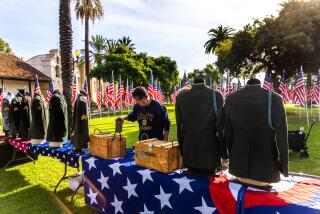Hawthorne honors others killed in Army depot accidents
- Share via
HAWTHORNE, Nev. -- The Hawthorne Ordnance Museum commemorates the history of the nearby Hawthorne Army Depot with display cases and showrooms bristling with bombs, bullets, mines, torpedoes and missiles.
Many of them came from the depot, which surrounds the town with thousands of squat storage buildings and half-buried ammo bunkers arranged in neat rows across hundreds of square miles of otherwise featureless desert.
Its newest exhibit, however, is a massive granite memorial funded with local donations and designed as a testament to decades of safe working conditions at the sprawling base, the economic backbone of the region since World War II.
The museum was preparing to place the memorial on a permanent stand near its entrance when a 60-millimeter mortar round exploded at the depot Monday night, killing seven Marines and injuring eight other servicemen -- seven Marines and a Navy corpsman. The dead and injured were from the 2nd Marine Expeditionary Force, headquartered at Camp Lejeune, N.C.
The granite block, which stands about 5 feet high and 18 inches wide, chronicles the men and women who “gave their lives for their country while employed at the Hawthorne Depot.”
A rocket explosion claimed the lives of three people on Oct. 1, 1951. The detonation of an 8-inch projectile killed two people on Sept. 30, 1966. A rocket detonation killed three others on May 26, 1971.
“That’s an impressive safety record,” said museum docent Howard Warner. “None of these people were in the military. All of them were munitions handlers and supervisors.
“Now, we may have to build another memorial for people in the military,” he added.
As Pentagon officials began a formal investigation into Monday’s tragedy, the museum became a gathering place for local veterans to share their theories about what may have happened on the base – and to take a close look at dozens of disarmed 60-millimeter rounds on display.
“Nobody knows what happened out there, and we won’t know until investigators talk to the survivors,” Warner said. “But this is a 60-millimeter mortar round,” he added, holding up one of the shells, which is about 12 inches long and a few inches in diameter.
“It’s fired into the air,” he said, “and when it hits, it’s got a 30-foot kill radius. What kills is the cast iron it’s made of, which shatters. It’s the shrapnel that cuts you to death.”
Warner, 75, paused, then added, “It’s one thing to be killed in combat. It’s another to be killed because someone screwed up. How do you explain that to the family?”
ALSO:
Marine Corps identifies 7 killed in training accident
It’s the law in Colorado: Gun background checks, ammo limits
Westboro Baptist Church’s new neighbor: a rainbow-painted house
More to Read
Sign up for Essential California
The most important California stories and recommendations in your inbox every morning.
You may occasionally receive promotional content from the Los Angeles Times.














